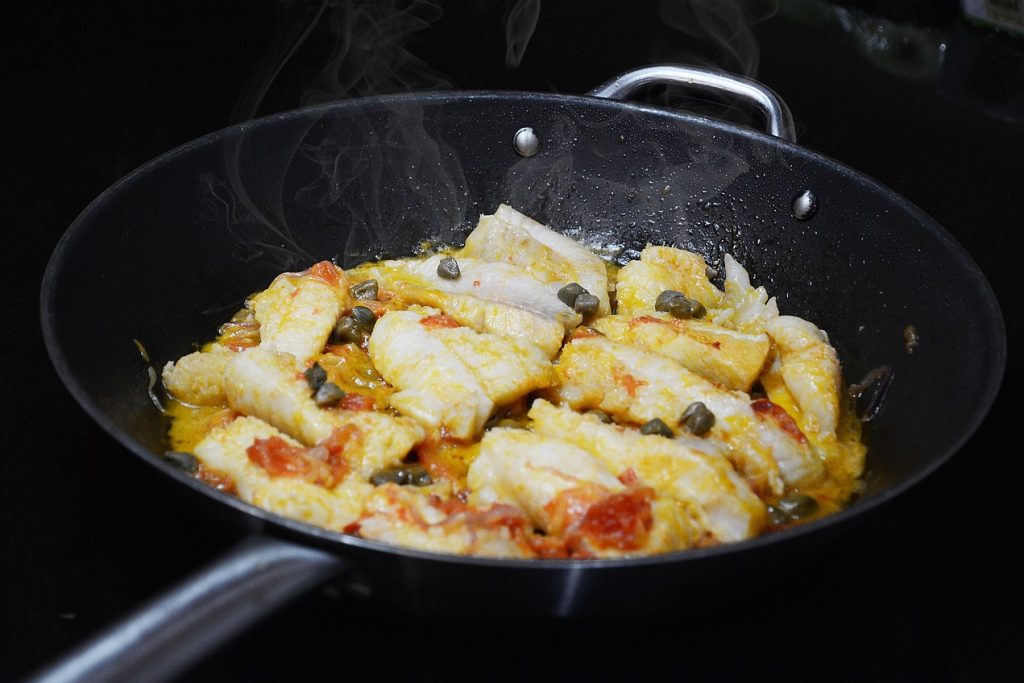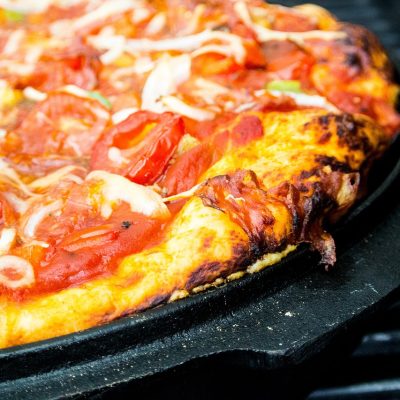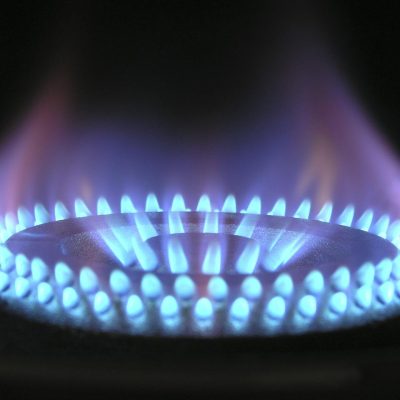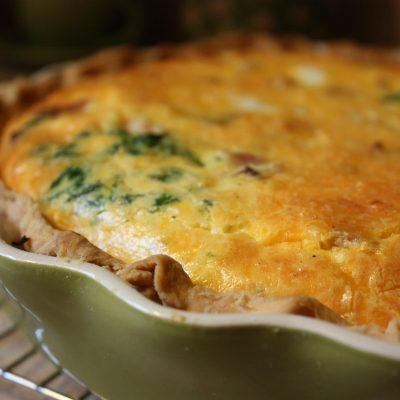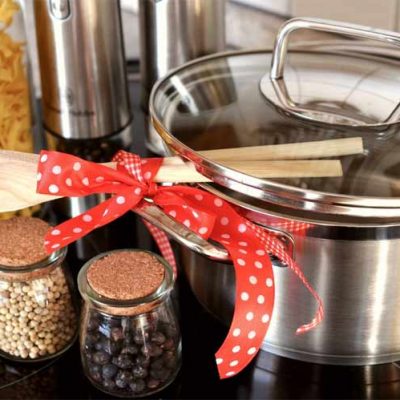Want the perfect pan to cook fish that won’t make your fillet stick, break, or cook unevenly? Searing salmon, frying tilapia, or steaming a whole snapper is all about the pan.
A good non-stick skillet or a decent stainless steel pan isn’t just a tool; it’s your secret weapon for crunchy skin, tender insides, and no-drama cleanup. This is a breakdown of the top pans for each style of fish cooking and how your choice of material impacts more than you ever knew.
Chef Thomas Keller says,
Using the right pan is the difference between fish that tastes like it came from a restaurant and a disaster for dinner.
What Type of Pan Is Best for Cooking Fish?
If you’re asking yourself, “What’s the best pan to cook fish on the stove?”, the answer will vary depending on your method.
For everyday home cooks, the most convenient and easiest choice is a stainless-clad frying pan or a nonstick pan.
However, if you’re obsessed with crispy skin or deep flavor, then a cast iron skillet or carbon steel pan is the MVP.
Key Tip: When pan-frying delicate fish such as flounder or trout, you should always pan-fry with a nonstick. When searing meaty fish such as tuna or swordfish, go stainless or cast iron.
What Should I Look for in a Pan for Fish?
In buying a pan solely to fry fish, it does not have to come at a high cost. Don’t shop based on looks or because it is a specific brand. Here is precisely what you are seeking:
Nonstick Coating
Why is a nonstick coating perfect for fish? Because fish is delicate and breaks apart so readily. A good nonstick coating lets you pick it up or flip it without the flesh tearing and adhering.
Tip: Use PFOA-free nonstick coatings such as Teflon Select or ceramic nonstick. They’re more durable and healthier than the originals.
Pan Size
What pan size is well-suited to fish fillets? 10-12 inch pan for most home cooks. It’s large enough to hold two fillets but small enough that heat can still be distributed evenly. Cooking a whole fish? Up to 14 inches.
Material & Heat Conductivity
Some pans heat up too fast and cause hot spots. Others are too cold and take forever to heat up. You need a medium-weight pan that heats well but isn’t terrible at retaining heat, i.e., carbon steel or stainless clad. These distribute the heat evenly up the fillet.
Versatility & Budget
Can you cook fish, eggs, and vegetables in the same pan? Yes, if you purchase a multi-purpose pan such as a stainless-clad pan or a cast iron pan. They’re more expensive, to begin with, but they’ll last you decades and be worth it.
6 Best Pans for Cooking Fish (Reviewed)
Let’s go through the best-rated pans by category. Used by pros, enjoyed by home cooks, and built to last.
1. Lodge Pre-Seasoned Cast Iron Skillet
If you ask most of the pros, “What is the ultimate pan for pan-frying fish with crispy skin?” and they’ll say cast iron. Lodge’s skillet is a legend.
Why it’s great:
- Pre-seasoned with 100% natural oil
- Great heat retention for deep-frying
- Oven, grill, stovetop, and even campfire-safe
- Perfect for thick fish like halibut or salmon steaks
- Non-toxic & chemical-free
Downside: It’s heavy and more difficult to clean (no soap!).
2. TECHEF Korean BBQ Nonstick Grill Pan
Feel like having grilled fish without the hassle of firing up the BBQ? This stovetop grill pan is pure genius.
Features:
- Swirl channel design drains off excess oil
- Teflon Select 5-layer nonstick (PFOA-free)
- Perfect for health-conscious, low-oil cooking
- Excellent for fish steaks, mackerel, or marinated fillets
Bonus: Also perfect for pork belly, vegetables, or tofu.
3. Made In Stainless-Clad Frying Pan
This is the chef’s top option for pan-frying fish without sticking, even without nonstick.
Why chefs love it:
- 5-layer construction (aluminum + stainless)
- Non-reactive surface (delicious with lemon, vinegar, and tomatoes)
- Dishwasher-safe
- Crisp exterior, tender interior
Use Case: Perfect for cooking dishes like lemon-butter cod, salmon piccata, or mahi mahi.
4. Misen Carbon Steel Pan
Carbon steel provides you with cast iron performance but is lighter and faster to heat.
What makes it stand out:
- Nonstick once seasoned
- Light and adaptable
- Bakes in the oven safely
- Great for blackened fish, fish, and crispy skin recipes
Tip: It has to be seasoned and cared for regularly, but it’s well worth the hassle.
5. Le Creuset Enameled Cast Iron Braiser
Need to braise fish or cook in a rich sauce? This braiser is your buddy.
Pros:
- Enameled inside for a snap-to-clean
- Tight lid to trap the water
- Looks like a showpiece on the table
- Ideal for fish curries, tomato dishes, or braised cod
6. All-Clad Nonstick Fry Pan
Want all the ease and no hassle? Use All-Clad.
Pros:
- Triple-layer nonstick
- Ergonomic handle
- Dainty flip of light fish
- Ideal for low-fat cooking
Best Used For: New cooks, harried parents, or easygoing Sunday fish tacos.
Avoid These Fish-Frying Fails
Even with the ideal pan, fish can be a disaster. Here are the most frequent blunders to steer clear of:
- Flipping too soon: Fish releases naturally when it’s done. Pressing it rips the meat.
- Not drying the fish first: Wetness = steam = no crust. Pat it dry with paper towels before preparing.
- Cold pan syndrome: Beginning with a cold pan results in pale, soggy fish. Preheat always.
- Overcrowding: Piling too many fillets into the pan at once lowers the temperature and results in cooking unevenly.
- Choosing the wrong oil: Butter burns quickly. Employ neutral high-smoke-point oils such as canola, grapeseed, or light olive oil.
Pro Bonus Tip: When cooking skin-on fish, press down gently on the fillet for the first 30 seconds to suppress curling.
Which Pan Material Is Best for Fish?
| Materials | Pros | Cons | Best for |
|---|---|---|---|
| Nonstick | Easy cleanup, beginner-friendly | Not oven safe, less crisp | Flaky fillets |
| Cast Iron | Heat retention, crispy skin | Heavy, high-maintenance | Deep-fried fish |
| Carbon Steel | Crisp texture, fast heat | Needs seasoning | Blackened fish |
| Stainless Steel | Acid safe, Sears well | Food may stick | Seared dishes |
| Copper | Precise temp control | Expensive | Chefs & enthusiasts |
TL;DR: Newbie? Use a nonstick. Restaurant-worthy sears or crispy skin? Carbon steel or stainless.
Matching Pan to Fish Type
| Fish Type | Best Pan | Why |
|---|---|---|
| Trout, Sole, Flounder | Nonstick | Delicate texture, easy to break |
| Salmon, Tuna, Swordfish | Stainless-Clad or Cast Iron | Thick and oily, needs searing |
| Tilapia, Catfish | Carbon Steel | Great for frying and crispiness |
| Whole Snapper or Sea Bass | Dutch Oven or Baking Tray | For roasting or braising |
| Cod or Halibut | Sauté Pan or Grill Pan | Versatile and juicy |
Final Thoughts:
Cooking fish doesn’t have to feel intimidating. Grilling salmon, pan-frying trout, or steaming sea bass all produce delicious fish, and the right pan makes it a breeze. Need to be easy-going?
Nonstick is the way. Need crispy skin? Cast iron or carbon steel is the way. Need sophistication and acid-friendly choices?
Stainless steel is your ally. If you want to be a fish master in your domestic kitchen, start your set with 2–3 pans that will fit your way of cooking.
Start off with nonstick for convenience, then carbon steel and stainless. Add healthy oil, solid heat, and fresh fish, and you’re already 90% there.
Frequently Asked Questions
Your best bet is a nonstick frying pan with a wide base, i.e., All-Clad or TECHEF. It is foolproof and does not need special seasoning.
Yes! Extra light olive oil (not extra virgin) is an extremely high smoke point oil and perfect for fish.
You are flipping too soon. Let the fish release from the pan naturally, typically 2–3 minutes per side, before flipping.
Not if uncoated. Acidic ingredients such as lemon or tomatoes will strip the seasoning. Use enameled cast iron instead.
Not quite. You’ll have to have at least 2–3 pans to be multi-functional, such as a nonstick, a cast iron, and a sauté pan.
It must flake easily under a fork, be firm, and opaque all the way through. Not certain yet? The flesh should spring back slowly when pressed.

